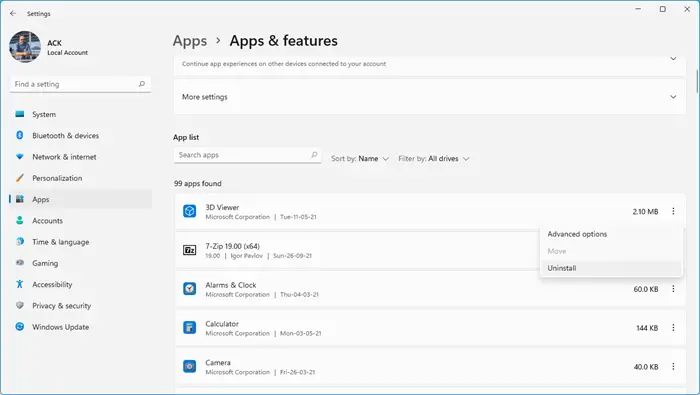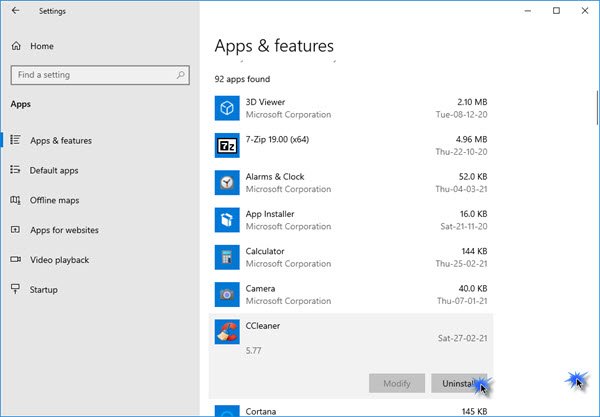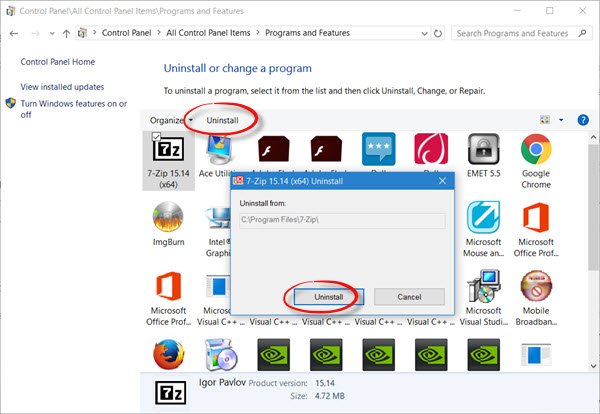Over a period of time, you may find that you may have installed several programs or software on your Windows 11 or Windows 10 computer. And it may also happen that some of the programs may have been uninstalled without your knowledge. It is, therefore, a good idea to take a look at the programs that may have been installed on your computer and delete, remove or uninstall the programs that you do not want.
How to uninstall a program in Windows 11/10
Uninstall program or app via Windows Settings

You can uninstall programs and apps using the Windows 11/10 Settings panel:
- Open Settings
- Select Apps > Apps & features
- Select the app you want to uninstall
- Click on the Uninstall button that appears.
That’s it. Windows will have uninstalled the program or app!
In Windows10, the settings look like this:

Read: How to Bulk Uninstall Programs and Apps.
Uninstall a Program using Control Panel

To uninstall a program using the Control Panel in Windows 11/10/8/7, you have to carry out the following steps:
- Open Control Panel
- Open Programs and Features applet
- Locate the program you wish to uninstall
- Double-click on it to uninstall it.
Let us see the procedure in detail.
Search for Control Panel in the Start Search and select it to open it.
Now look for Programs and Features and click on it to open the applet that lets you Uninstall or change a program.
Locate the program you wish to uninstall and double-click on it.
You will be asked for confirmation. Confirm by pressing the Uninstall button, and the uninstallation process will commence.
You can also right-click on the icon and select Uninstall from the context menu that appears, or you could simply select the program icon and click on the Uninstall link.
If the program offers this option, you may also be offered a link to Change or Repair the program.
Once the removal process is complete, you will receive a confirmation. You may also be asked to restart your computer to complete the uninstallation process. Do so.
How do I completely uninstall a program in Windows?
If you are a little familiar with the working of Windows, additionally, after you have uninstalled the app or program via Settings or Control panel, you could do the following to completely uninstall programs:
- Check the Programs folder where the program was installed, and delete the uninstalled programs folder if you still find it there.
- You could also Show hidden files via the File Explorer Options, and search for the uninstalled programs’ name. Say you uninstalled McAfee – then search for McAfee and delete all folders and files that may be found.
- Do the same in the Windows Registry. Create a System Restore Point and the Run regedit, press Ctrl+F, and search for McAfee. Delete the keys found. Do this only if you are familiar with working with the Registry.
If for some reason you are unable to uninstall programs, you may find the following links helpful:
Thanks Andy for showing how to do this action, in Windows. Though most of us who read The Window Club are fairly to quite savvy about computers – It is nice to be able to show the less knowledgeable users, how to do this. The pictures are excellent and a good training tool, for those who don’t know how to do this action. :)
I happen to use Revo Uninstaller Pro. I used the free version for years, because Windows Add and Remove program had a nasty habit of not removing everything. I believe, Windows later versions of this program have done a lot better. However, I have gotten use to Revo and love it.
I found that the free version of Revo works just as good as the paid version. I continue to use the paid version, because at this point there isn’t a yearly subscription, your license is a Lifetime one. I still think that everyone should know, whatever Windows version they are using, how to work all of Windows programs available to them.
Hi MmeMoxie, You’d be surprised, but many still want to know things like these or how to create a system restore point, so I have started posting basic tutorials too. REvo is good and I too use it. :)
I totally agree with you. Plus, all of us savvy users need review now and then, too. Again, thanks for the article.